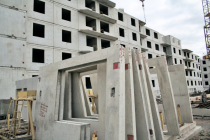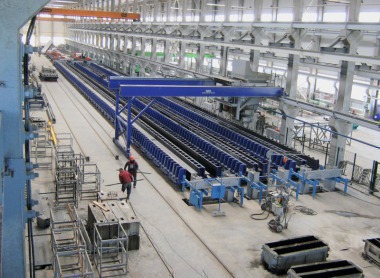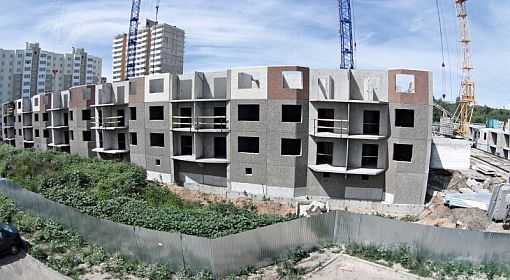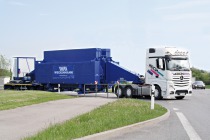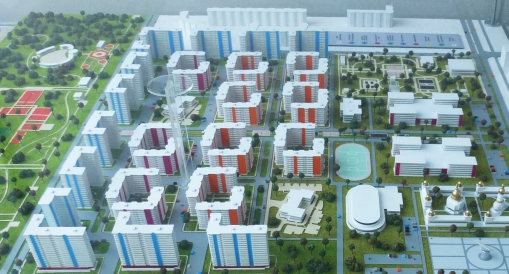Vollert|Weckenmann plant ensures high production output and quality
In 2008 DSK Blok launched the most modern production plant for precast components in St. Petersburg. DSK Blok belongs to the North-West Russian LSR Group, a leading company in the construction and construction materials industry. The group plans to use its two precast plants to achieve a construction performance goal of 750,000 m2 floor space annually by 2011. To this end, 19 million euros were invested during the first stage; the current aim is to manufacture 180,000 m3 precast components annually from now on.
DSK Blok was established in 1992. The support of a 2,000 employee workforce and the use of conventional technology have helped the company establish its good market position. The company grounds cover an area of 46 ha and 30,000 m2 storage space are available. The decision to modernize the precast plant was made in connection with the change of the construction method for multi-story residential buildings: In contrast to the common Russian technology, DSK Blok no longer builds the external walls as a sandwich construction, but as loadbearing solid walls with thermal insulation. The more efficient technology offers a number of advantages, e.g. accelerated construction progress and the elimination of all joints in the façades (Fig. 1).
Project flow In 2006, a competent team from DSK Blok contacted Vollert|Weckenmann through its local representative, Anton Ohlert, and formulated the ambitious aim of doubling its production capacity. Jointly with the engineers a concept was developed for cost-efficient manufacture of loadbearing and non-loadbearing walls and solid-concrete floors of high quality. For this purpose, vertical production with battery forms for the wall elements and a pallet rotation system for horizontal production of the floor slabs was chosen. Despite the great spatial distance between them, the two project teams sustained their efficient, result-oriented collaboration.
The Vollert|Weckenmann battery form system in particular impressed the Russian team. The system was once again decisively improved in two respects: in vibration engineering and with regard to heat curing. Due to the fluctuating quality of the aggregates, the client had desired optimal compaction and correspondingly high-quality surfaces. At the same time, high requirements were made on the early strength of the concrete – the heating and its control was therefore of great significance.
Pallet rotation with curing chamber The solid floors were manufactured in a standard width of 3.59 m, a thickness of 160 mm and a maximum length of 6.00 m. The pallet rotation plant is fitted with 40 pallets of size 3.90 x 12.50 m and provided on their long sides with a sideform that is permanently screwed on (Fig. 2). Longitudinal and transverse form with integrated, strong magnets complete the form system. The curing chamber has 40 storage positions. The chamber is completely lined with insulated panels. Every storage position can be accessed via a segmental gate that must be opened separately. The actuation of the gate as well as pallet feeding is effected by a rack serving unit that operates outside the heated area. Infinitely adjustable drives and rapid in- and outstorage characterize this unit (Fig. 3).
Heating is provided by thermo oil, which – controlled by a temperature controller – is conducted through spiral-ribbed pipes located in the chamber floor.
Vertical production in battery forms In the two adjacent hall bays a total of nine battery forms size 7.18 m x 2.60 m; 5.68 m x 2.60 m as well as 3.88 m x 2.59 m are set up (Fig. 6). The wall elements are manufactured in thicknesses of 120 and 160 mm; every form has 2 x 10 compartments. The existing construction was optimized in respect of the structural design and the vibration option via the fine element method. This method made it possible to reduce the number of vibrators. This measure has an especially positive influence in terms of noise development, costs, energy consumption and wear. Another advantage of the Vollert|Weckenmann battery forms are the floor-bound undercarriages for the form panels, powered by electric motor. These provide, first of all, the workers with almost unrestricted access to the spaces between the compartments and enable them to carry out their individual tasks. Secondly, the compartments can be easily moved without great physical effort. All panels are fitted with heating registers that are supplied with thermo oil from a heating center (Fig. 7). A sensor fitted to each half of the form communicates the current temperature value to a monitor that controls the temperature flow and the duration of the heating. The bottom and the vertical form panels are made of steel and are provided with sealed edges. They can be quickly and precisely adjusted to the standard dimensions predefined by Blok. The compaction technology conceived in collaboration with a specialist for vibration incorporates a number of innovations that were previously never before realized worldwide. The 748 synchronous vibrators that were developed specifically for this project provide an exact rotational speed of 6,000 rpm at a frequency of 100 Hz. These vibrators are of extra-narrow design and fit into special assembly pockets, taking up little space (Fig. 8). The bearings and the cables are suitably fitted to withstand high temperatures. The vibrators are activated by two control systems with a frequency converter as central component, which is controlled by a PLC. All vibrators can be controlled und monitored via touch panels that display the current operating status. The control system is supported by a radio terminal, one each for every battery form. The individual touch panels are of redundant designed so that every battery form within the hall can be operated from every panel. DSK Blok also uses prefabricated reinforcing cages for vertical production; the cages were installed in the battery form by crane. Concrete casting takes place by two semi-portal spreaders fitted with a porcupine roller batching unit that delivers the concrete via a hydraulically driven swivel-type filling aid that places the concrete precisely into the compartments (Fig. 9). A skip conveyer ensures continuous concrete supply. The elements manufactured are characterized by a nearly pore-free surface with cleanly executed edges (Fig. 10). The tight dimensional tolerances guarantee a rapid and smooth erection process.
Transport, erection and commissioning The Vollert|Weckenmann logistics department had to coordinate and execute the transport of a total of 75 trucks with a total weight of 1,300 t within a period from December 2007 to June 2008; most hauls involved excess widths and, accordingly, special transport on the way to St. Petersburg. Upon arriving, the circulating plant was erected first under expert supervision: up to four chief erectors supervised and organized the qualified erection crew provided by Blok. All of the preliminary work that Vollert|Weckenmann had specified to be carried out was perfectly executed by the Russian client and ensured erection of the plant on schedule. The project team met regularly to check the flow of erection. Necessary corrections were immediately pinpointed and implemented exactly where required.
Training of the operating personnel and instruction in the use of the plant The operating personnel that had already participated in the erection of the plant on location was intensively trained and instructed in its use. The chief supervision from Vollert|Weckenmann handed over the plant only after ensuring that the plant could be perfectly operated by the Russian workers. Intensive after-sale support of a plant of this dimension is, it goes without saying, especially important. The maintenance of the plant is additionally supported by remote diagnosis of the controls via modem. The appropriate persons and departments on the part of Vollert|Weckenmann are permanently available to the client. The use of component suppliers of international renown, moreover, makes it possible for the client to rapidly access their service networks.
Summary This investment has strengthened the position of DSK Blok in Greater St. Petersburg as an important manufacturer of high-quality precast components. Both the production quantity and the quality achieved set a new benchmark for this Russian market, second only to Moscow. Vollert|Weckenmann and its partners proved their merit through competent consultation, professional project management and implementation of the latest technology.

